31.01.2007
Corus Tournament in Wijk aan Zee: a Creative Survey (Rounds 1-2)
Round 1
Topalov,V (2783) - Motylev,А (2647) [D12]
1.d4 d5 2.c4 c6 3.¤f3 ¤f6 4.e3 Ґf5 5.¤c3 e6 6.¤h4 Ґg6 7.Јb3 Јc7 8.Ґd2 ¤e4! Well, really! Black has left the opening problems behind by the 8th move. Working in Vladimir Kramnik`s team at the match does not seem a waste of time for Alexander Motylev.
9.¤xg6 ¤xd2 10.ўxd2 hxg6
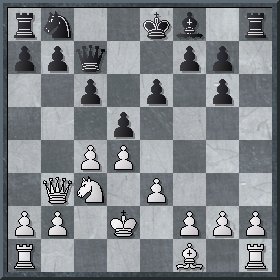
11.¦c1 Јb6 12.c5 Јxb3 13.axb3 ¤d7 14.b4 a6 15.¦a1 ¦b8 To offer bishop on a6 is risky and allows to achieve only equality at best, so the struggle shifts to the centre, where the absence of White dark-squared bishop is telling – Black has a small advantage.
16.ўc2 Ґe7 17.Ґe2 f5! 18.h3 ўf7 19.f3! [After 19.f4 there would follow 19...g5] 19...e5 20.dxe5! If Black is allowed to make an exchange then White gets a weakness on d4, that can be exploited by Ґe7-f6 and transferring the knight over f8 to e6.
20...¤xe5 21.f4! ¤d7 22.Ґd3 ¦be8 23.¦hf1 Ґf6 24.ўd2 ¦e7 With a series of precise moves Veselin Topalov manages to stabilize the position, and after 25.¦f1-f3 both opponents have nothing to worry about – the position is equal.1/2-1/2
Van Wely,L (2683) - Radjabov,Т (2729) [E97]
1.d4 ¤f6 2.c4 g6 3.¤c3 Ґg7 4.e4 d6 5.¤f3 0-0 6.Ґe2 e5 7.0-0 ¤c6 8.d5 ¤e7 9.b4 ¤h5 10.¦e1 f5 11.¤g5 ¤f6 12.f3 ўh8 13.¤e6 Ґxe6 14.dxe6

14...¤h5! Stronger than in the previous game between the opponents. Opening of files is generally not in White`s favor, and this is particularly true for light-colored squares: 14...fxe4? 15.fxe4 ¤c6 16.¤d5 ¤xe4 17.Ґf3 ¤f6 18.b5 ¤xd5 19.bxc6 ¤b6 20.cxb7 ¦b8 21.c5 and White has a decisive advantage, van Wely-Radjabov, Khanty-Mansiysk 2005. This time Teymour demonstrates the strategy of dark-colored squares` blocade, which is much stronger and more logical.
15.g3

15...Ґf6! The g7-square is free for the knight, and at the same time the bishop has some prospects for getting into a fight over g5 or h4.
16.c5 An attempt for indirectly defending the e6-pawn is waiting for its following practical application: 16.Ґh6 ¤g7 and now after 17.b5 (after 17.¦b1 besides 17...¦e8 18.¤d5 ¤c6 also interesting 17...¤xe6!? 18.Ґxf8 Јxf8) there is an intriguing sacrifice of exchange -

17...¤xe6!? (17...¦e8 18.¤d5 ¤c6) 18.Ґxf8 Јxf8! , with good compensation.
16...f4 17.g4 More flexible reaction is 17.ўg2 . Running a few steps forward let us mention that in the 3rd round Alexey Shirov would strengthen the play for White in the same way.
17...¤g7 18.Ґc4 ¤c6 19.cxd6 cxd6 20.¤e2 White has to do that to defend against ¤c6-d4, but such moves bring no luck, Black has an advantage. [After 20.¤b5 a simple 20...¤xe6 gives at the least a comfortable advantage]
20...¦c8 Black has finishedmobilization of his forces, and the only unpleasant thing for him is a "nag" on e6, but the great advantage in development outweighs such "trifles".
21.Ґd5 ¤xb4 The pawn is taken "in stride"- if it was not there, the same move would quite probably follow.
22.¦b1 ¤c2 Blackin his turnorganize "a thorn in White`s side" on e3.
23.¦f1 b6 Another soldiercaptures the dark-colored square –White seems to be running out of active moves, while Black shows no signs of this deficiency.
24.¦b2 ¤e3 25.Ґxe3 fxe3 26.Јb3 Ґg5 27.¤c3 More stubborn is 27.¦c2 , in this case Black is at least deprived of an attack along c-file.
27...¦c5 28.¤a4 ¦c7 29.¤c3
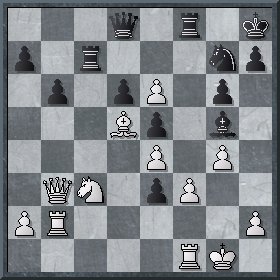
29...Јc8 30.¤b5 ¦c1 31.¦b1 ¦xf1+ 32.¦xf1 Јc5 33.ўg2 ¦c8 Depriving the knight of retreat onc3.
34.¦e1 a6 35.¤a3 Јd4 Also strong is 35...b5 , stressing an unfortunate position of a3-knight.
36.¦e2 No better is 36.¦d1 Јc3 37.Јxc3 (or 37.Ґc4 e2 38.Ґxe2 Јxb3 39.axb3 ¤xe6) 37...¦xc3 38.Ґb3 ¤xe6 39.Ґxe6 ¦xa3 40.Ґb3 a5 41.¦xd6 a4 42.Ґc4 ¦c3 43.Ґd3 Ґh4 , and Black wins.
36...¦c3 37.Јb2 h5 38.h3 Јd1 39.Ґb3
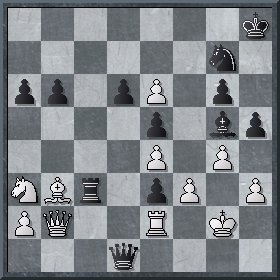
39...¦xb3! A nice ending as the curtain falls. 40.axb3 ¤xe6 0-1
Karjakin,C (2678) - Kramnik,V (2766) [C42]
1.e4 e5 2.¤f3 ¤f6 3.¤xe5 d6 4.¤f3 ¤xe4 5.¤c3 ¤xc3 6.dxc3 Ґe7 7.Ґf4 0-0 The move7...¤c6 is considered safer, preparing for the development of light-squared bishop with following Јd8-d7 и 0-0-0. In this branch White usually gets an advantage of bishop pair, but Black`s armor is exceptionally strong.
8.Јd2 ¤d7 9.0-0-0 ¤c5 10.Ґe3 The other well-known possibility 10.h4 apparently leads to just a little bit more problems.
10...¦e8 11.Ґc4 Ґe6 12.Ґxe6 ¤xe6 13.h4 Јd7 14.Јd3 Јc6 15.Јf5
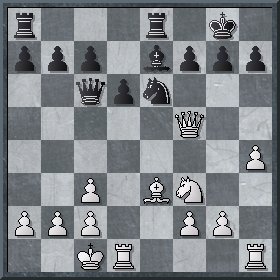
15...Јc4 A novelty, Black deprives the White queen of the possibility to retreat on d3- and g4-squares.
16.¤g5 More logical is 16.ўb1 , and although after 16...g6 White has to retreat 17.Јh3, it is probably just the way to struggle for initiative.
16...Ґxg5 17.hxg5 ¤f8 18.ўb1 ¦e5 19.Јd3 Јxd3 20.cxd3 ¦ae8 21.¦h3
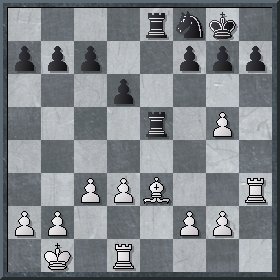
21...b6! Vladimir deployshis pawns on dark squares, constricting the White bishop. The position gets level. 22.ўc2 ¦5e6 23.¦dh1 f6 24.gxf6 ¦xf6 25.d4 d5 26.ўd3 h6 27.¦h5 c6 28.b3 ¦g6 29.¦g1 ¤d7 30.g4 ¤f6 31.¦h4 ¤e4 32.¦h5 ¤f6 33.¦h4 1/2-1/2
Shirov, A (2715) – Svidler, P (2728) [D87]
1.d4 ¤f6 2.c4 g6 3.¤c3 d5 4.cxd5 ¤xd5 5.e4 ¤xc3 6.bxc3 Ґg7 7.Ґc4 c5 8.¤e2 ¤c6 9.Ґe3 0-0 10.0-0 Ґd7 11.¦b1 Јc7 12.Ґd3 Anotherdirection known in theory is 12.Ґf4 Јc8 13.d5 ¤a5 14.Ґd3 e5
12...¦ad8 13.Ґf4 13.Јc1 , avoiding the opposition with black rook, seems more preferable.
13...Јc8 14.d5 ¤e5 Assuredly not 14...¤a5, and the move 12...¦ad8 becomes senseless – Black has to struggle for centre.
15.Ґxe5 Ґxe5 16.f4 Ґg7 17.c4 The dark-squared bishop is exchanged, and its absence tells on every variation 17.e5 e6 18.d6 f6 , and White`s centre collapses. 17...e6
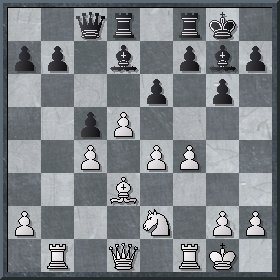
18.f5!? Alexey Shirov plays a bit too straightforwardly andfaces Peter Svidler`s brilliant reaction. After seemingly flexible 18.ўh1 the same 18...b5!, would follow, so it was worth it to think over pre-emptive 18. Јb3 or even 18.a4.
18...exf5 19.exf5
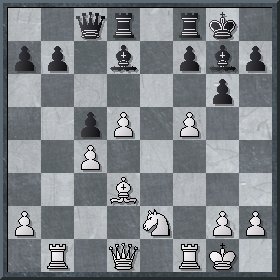
19...b5! 20.f6 Ґh6 21.¤c3 bxc4 22.Ґxc4 Ґf5?! К сожалению, Петр не решается сыграть на победу 22...Ґe3+ 23.ўh1 Ґd4 , получая перевес.
23.Ґd3 Ґg4 24.Ґe2 Ґf5 25.Ґd3 Ґg4 26.Ґe2 Ґf5 1/2-1/2
Tiviakov,S (2667) - Carlsen,М (2690) [B22]
1.e4 c5 2.c3 Practically everything is already known about this move.
2...¤f6 3.e5 ¤d5 4.¤f3 ¤c6 5.Ґc4 ¤b6 6.Ґb3 d5 Move order chosen by White permits Black to have luxuriant game 6...c4!? 7.Ґc2 Јc7 8.Јe2 g5! In this way I managed to beat Sergey (Tiviakov-Sakaev, Khanty-Mansiysk 2005). Magnus Carlsen prefers a simpler variation.
7.exd6 Јxd6 8.¤a3 a6 9.0-0 Ґf5 10.d4 cxd4 11.¤xd4 ¤xd4 12.cxd4 e6 13.Јf3 Јd7 14.d5 ¤xd5 15.¦d1 Ґxa3 16.bxa3 0-0 17.h4 ¦ac8 18.Ґxd5 exd5 19.¦xd5 Јe6 20.¦xf5 Јe1+ 21.ўh2 ¦xc1 22.¦xc1 Јxc1 23.Јxb7 Јxa3 24.Јd5 All this has already occurred in practice...1/2-1/2
Navara,D (2719) – Aronian,L (2744) [D38]
1.¤f3 ¤f6 2.c4 e6 3.¤c3 d5 4.d4 Ґb4 5.cxd5 exd5 6.Ґg5 ¤bd7 7.¦c1 c6 8.e3 Јa5 9.Ґd3
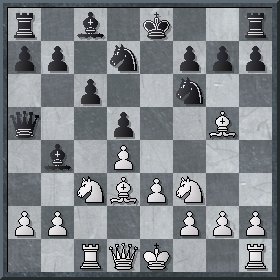
9...Јxa2! Without prejudices.
10.0-0 Јa5 11.¤e5 0-0 12.Јf3 Unexpectedly leads to a draw. [To the complex double-edged play leads12.f4!? ]
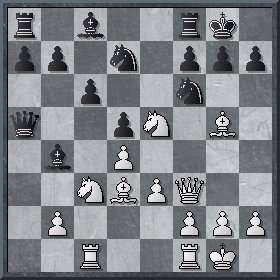
12...¤xe5! 13.dxe5 ¤g4 14.Јg3
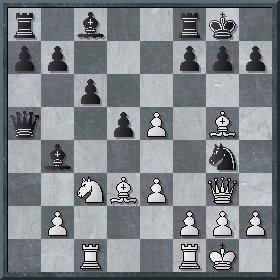
14...¤xe5 14...f6 also would lead to a draw 15.exf6 ¤xf6 16.¦a1 Јc5 17.¤a4 Јa5 18.¤c3 , with move repetition.
15.Јxe5 f6 16.Ґxf6 ¦xf6 And here is another possible way to draw 16...gxf6 17.Јg3+ ўh8 18.Јh4 ¦f7 19.¦a1 Јb6 20.¤a4 Јa5 21.¤c3
17.Јe8+ ¦f8 [On 17...Ґf8 White finds 18.¤xd5!] 18.Јh5 h6 19.Јg6 ¦f6 20.Јe8+ ¦f8 21.Јg6 ¦f6 22.Јe8+ 1/2-1/2
Ponomariov,R (2723) – Anand,V (2779) [E05]
1.d4 ¤f6 2.c4 e6 3.g3 d5 4.Ґg2 Ґe7 5.¤f3 0-0 6.0-0 dxc4 7.Јc2 a6 8.Јxc4 b5 9.Јc2 Ґb7 10.Ґd2 ¦a7 11.¦c1 Ґe4 12.Јb3 ¤c6 13.e3 Јa8 14.Јd1 ¤b8 15.Ґa5 ¦c8 16.Ґb6 ¦b7 17.Ґc5 Ґxc5 18.dxc5 ¦a7 19.¤bd2 Ґd5 20.Јc2 a5 21.a3 a4 22.Јd3 This gameis of no great interest. Playing against a very awkward opponent, Ruslan proposed a draw right in the end of opening, which was accepted by Anand, who usually tries not to take chances while playing with Black.1/2-1/2
Round 2
Svidler,P (2728) - Tiviakov,S (2667) [B01]
1.e4 d5 The Scandinavian defence is a substantial part of Sergei Tiviakov`s opening repertoire. As I recall, I have been greatly tempted to play 1.e4 (I seldom play in this way) during my match against him in Khanty-Mansiysk, but was troubled by other openings played by Sergei.
2.exd5 Јxd5 3.¤c3 Јd6 4.d4 ¤f6 5.¤f3 a6 6.g3 Ґg4 7.h3 Ґh5 8.Ґg2 ¤c6 9.0-0 0-0-0 10.Ґf4 Јb4 11.g4 Ґg6
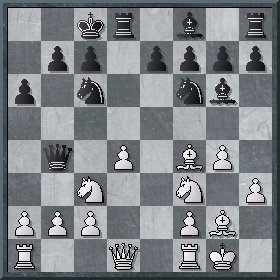
12.a3! Јc4 12...Јxb2 13.Јe1! , with terrible attack.
13.g5 ¤d5 14.¤xd5 ¦xd5 15.c3!? The most solid and probably the strongest move. 15.¤e5 ¤xe5 16.Ґxd5 Јxd5 is not so convincing, Black gets compensation for an exchange, although it is possibly not quite sufficient. 15...¦d8
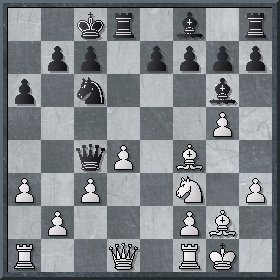
16.b3!? Јd3! 16...Јxc3 17.d5 and Black will be mated before he has time to develop his kingside
17.Јc1 Јc2 18.Јe3 e6 19.b4 Јe4 20.¤d2 Јxe3 21.fxe3 This ending is of middle game character; under cover of the strong pawn center White can develop his initiative on queenside. After some struggle and some mistakes Peter still managed to break down Sergei`s resistance.
21...e5 22.Ґg3 exd4 23.cxd4 Ґd6 24.Ґxd6 cxd6 25.¦ac1 ўd7 26.¤c4 h6 27.¤b6+ ўe8 28.gxh6 ¦xh6 29.¤d5 f6 30.a4 Ґf7 31.b5 axb5 32.axb5 ¤a5 33.¦a1 ¤c4 34.¦a7 ¦h5 35.¤c7+ ўf8 36.Ґxb7
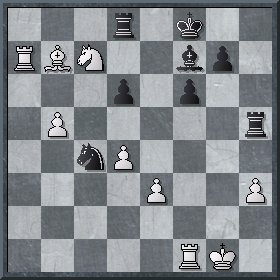
36...¦xh3?! [Central pawn is more seductive 36...¤xe3! ] 37.¦f3 ¦h5 38.Ґc6 ¦b8 39.¦g3 ¤b6 40.e4 ¤c8 41.¦a1 ¦h4 42.¤a6 ¦b6 43.¤b4 ¦b8 44.¦ga3 ¤b6 45.¦a7 d5 46.¤a6 ¦d8 47.¦b7 ¤c4 48.¤c5

48...dxe4 [48...¤d6 49.¦d7 ¦xd7 50.¤xd7+ ўe7 51.¦a7 ¤c8 52.b6! is also advantageous for White] 49.¦aa7 ¦g4+ 50.ўh2 ¤d6 51.¦xf7+ ¤xf7 52.¤e6+ ўg8 53.¤xd8 ¤g5 54.Ґd5+ ўh7 55.¤e6 ¤f3+ 56.ўh3 f5 57.¦xg7+ ¦xg7 58.¤xg7 ¤xd4 59.b6 e3 60.ўg2 ¤c2 61.ўf1 ¤b4 62.b7 ¤a6 63.¤xf5 ўg6 64.¤e7+ ўf6 65.¤c6 1-0
Aronian,l (2744) – Ponomariov,R (2723) [E32]
1.d4 ¤f6 2.c4 e6 3.¤c3 Ґb4 4.¤f3 d6?! Ruslan is unprepared to theoretical discussions after 4...b6 5.Ґg5 or 4...с5 5.g3
5.Јc2 ¤bd7?! Knight is better to move onс6, switching to well-known variation of the Nimzo-Indian defense.
6.g3! The position is already uncommon enough, so Levon Aronian`s answer is worth praising: White does not lose a tempo playing a2-a3, taking the opportunity of Black failing to exert pressure on d4-square.
6...c5?! 7.Ґg2 0-0 8.0-0 a6 9.¦d1 cxd4 10.¤xd4 Јc7 11.b3 If the black bishopcould return to e7, the "hedgehog" would be quite tolerable.
11...d5?! This is bad, but anyway it is already hard to understand in what way Black intends to finish development.[Still it was worth to prefer 11...¤e5 ]
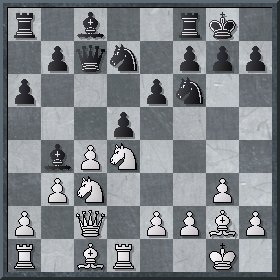
12.¤a4! Opening of the linesis advantageous for White with his gorgeous Catalan g2-bishop.
12...dxc4 13.Јxc4 Јxc4 14.bxc4 ¦e8 15.¦b1 Ґf8
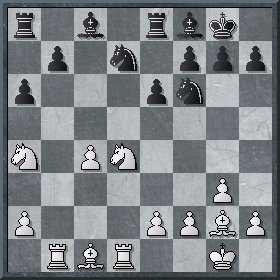
16.Ґd2! Here and later Levon Aronian shows his fine technique.
16...e5 17.¤b3 e4 18.c5 ¤d5 19.Ґe1 ¤7f6 20.¤a5 ¦a7 21.e3 Ґd7 22.¤c3 Ґc6 23.¤xc6 bxc6 24.¤xd5 ¤xd5 25.Ґa5 g6 26.Ґf1 ¦aa8 27.¦bc1 Ґh6 28.¦c2 ¦ab8 29.Ґc4 ¤b4

30.Ґxb4! ¦xb4 31.¦d7 ¦f8 32.Ґxa6 ¦fb8 33.Ґc4 ¦4b7 34.Ґxf7+ ўf8 35.Ґe6 Ґg5 36.¦d4 ¦e7 37.Ґb3 Ґf6 38.¦d6 ўg7 39.¦xc6 1-0
Topalov,V (2783) – van Wely,L (2683) [B90]
1.e4 c5 2.¤f3 d6 3.d4 cxd4 4.¤xd4 ¤f6 5.¤c3 a6 6.Ґe3 e5 7.¤b3 Ґe7 8.Јd2 An uncommon move with an idea of playing f2-f4 in contrast with conventional 8.f3.
8...0-0?! It is necessary to play8...Ґe6 anyway.
9.0-0-0 b5?! Now this is a serious blunder,9...Ґe6 would lead after 10.f3 to a well-known position, but still White has a possibility to play 10.f4, and also10.ўb1, which would lead to a quite unexplored position.
10.f3 Ґe6
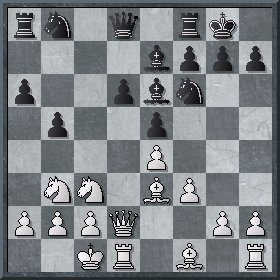
11.¤d5! 11.g4 would transpose into a well-known position, in which Black usually plays 11...¤bd7 12.g5 b4 13.¤e2 ¤e8 or 11...b4 12.¤d5 Ґxd5 13.exd5 a5, with good counterplay in both cases. With a powerful play Topalov prevents all this.
11...Ґxd5 12.exd5 Јc7 13.g4 ¦c8 14.ўb1 b4 15.g5 ¤fd7 16.h4 White has great advantage, his initiative develops much faster.
16...a5 17.Ґh3 a4 18.¤c1 ¤a6 19.h5 ¦cb8 20.g6 Ґf6 21.gxf7+ ўxf7 22.Ґe6+ ўf8
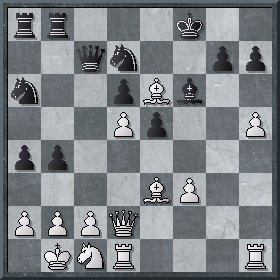
23.b3! A typical way to blocade Black`s play on the queenside. [After immediate 23.Јd3 Veselin might have disliked 23...b3! with counterchances.]
23...¤dc5 24.¦hg1 Јe7 25.Ґf5 ўg8? The only chance was 25...e4 26.f4 ўg8 , although White`s edge is great.
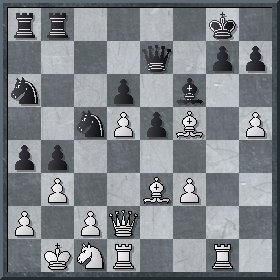
26.Ґxc5 ¤xc5 27.Јh6 ўf8 28.Јxh7 Јf7 29.¤d3 axb3 30.cxb3 ¤xd3 31.¦xd3 e4 32.Ґe6 exd3 33.Ґxf7 ¦xa2 34.Јg8+ ўe7 35.ўxa2 1-0
Radjabov,T(2729) – Kariakin,S(2678) [E15]
1.d4 ¤f6 2.c4 e6 3.¤f3 b6 4.g3 Ґa6 5.b3 Ґb4+ 6.Ґd2 Ґe7 7.Ґg2 c6 8.Ґc3 d5 9.¤e5 ¤fd7 10.¤xd7 ¤xd7 11.¤d2 0-0 12.0-0 ¦c8 13.e4 b5 14.¦e1 dxe4 15.¤xe4 bxc4 16.Јe2 ¦b8 17.¤c5! A widely-known method in this variation. [17.Ґf1 that Alexey Shirov has used recently against the same Sergei Kariakin, seems weaker]
17...Јc8 17...¤xc5 18.dxc5 leads to the exclusion of a6-bishop from the game.
18.bxc4 Ґf6 18...¤b6 19.¤xa6 Јxa6 20.d5 is advantageous to White.
19.¤e4 Ґe7 20.¦ac1 ¦e8 21.Ґa1 White defends the c4-pawn andprepares for d4-d5.
21...Јc7 22.Јd2 Ґb4 23.Ґc3 Ґa3 24.¦c2 Ґf8
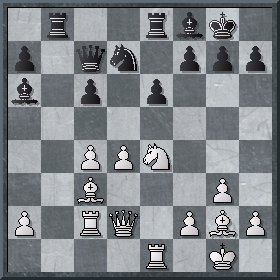
25.d5 Anatoly Evgenievich Karpov would have surely played 25.c5! here and then strangled Black bit by bit. Теimour chooses an explosive continuation.
25...exd5 26.cxd5 cxd5 27.Ґxg7 Јxc2 28.Јxc2 Ґxg7 29.Јc6 dxe4 30.Јxa6 ¤f6
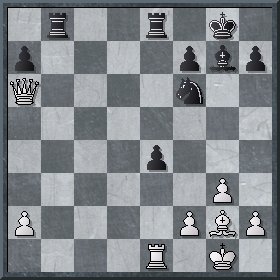
31.Јxa7? With one-flank play Black is very close to a draw, any move keeping the a-pawns on the board would have been better.Even the comfortable taking of e4-pawn fails to justify White`s play.
31...¦a8 32.Јb7 ¦xa2 33.Ґxe4 ¤xe4 34.¦xe4 ¦xe4 35.Јxe4 h6 36.h4 ¦d2 37.Јe8+ Ґf8 38.ўg2 ¦d6 39.Јe5 ¦e6 40.Јf5 Ґe7 41.ўh3 Ґf8 42.f4 [Black`s principal point is: 42.g4 Ґe7 43.g5 hxg5 44.hxg5 ¦g6 45.f4 Ґxg5 46.fxg5 ¦e6 and there is a fortress on the board.] 42...Ґe7 43.ўg2 ¦b6 44.Јh5 ¦e6 45.ўf3 ¦b6 46.Јg4+ ўf8 47.Јh5 ўg7 48.Јd5 ¦a6 49.ўg4 ¦a3 50.ўh3 Ґf6 51.ўg2 ¦c3 52.Јf5 ¦a3 53.Јg4+ ўh7 54.Јh5 ўg7 55.Јd5 ¦c3 56.h5 ¦e3 57.g4 ¦e6 58.g5 hxg5 59.fxg5 Ґxg5 60.Јxg5+ ўh7 61.ўf3 ¦h6 62.Јf5+ ўg7 63.Јe5+ ўh7 64.Јe4+ ўg7 65.Јd4+ ўh7 66.ўg4 ¦e6 67.ўg5 ¦h6 68.Јc4 ўg7 69.Јa2 ¦e6 70.Јa1+ ўh7 71.ўf5 ¦h6 72.Јa2 ўg7 73.Јb2+ ўh7 74.Јc3 ¦e6 75.ўg5 ¦h6 76.Јc4 ўg7 77.Јxf7+ ўxf7 78.ўxh6 1/2-1/2
Kramnik,V (2766) – Shirov,A (2715) [A16]
1.¤f3 ¤f6 2.c4 g6 3.¤c3 d5 4.Јa4+ Ґd7 5.Јb3 dxc4 6.Јxc4 Ґg7 7.e4
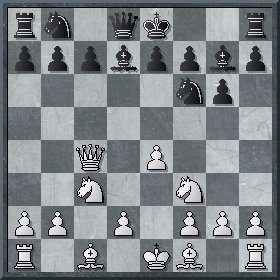
7...c6? It is well-known that it is necessary to play 7...Ґc6 , but Alexey is not ready for a rare variation of Anti-Gruenfeld.
8.d4 b5 9.Јb3 a5 10.e5 a4 11.Јd1 ¤d5 12.¤xd5 cxd5 13.Ґe2 Position is defined, White has a great advantage primarily at the expense of the weakened c5-square.
13...¤c6 14.0-0 0-0 15.Ґe3 ¤a5 16.b3 axb3 17.axb3 Јb6
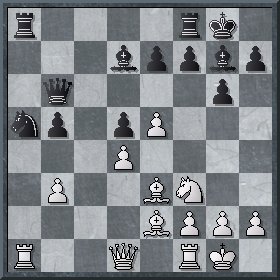
18.¤e1 The knight aims atс5.
18...b4?! Thelight-squared bishops exchange is good for Black, but he pays a high price for it: time is lost, and the pawn moves to a vulnerable dark square. 18...¤c6! is more stubborn, as it prevents the transference of the white knight.
19.¤d3 Ґb5 20.¤c5 ¤b7 21.¦xa8 ¦xa8 22.Ґxb5 Јxb5

23.Јd3! Јc6 24.¤a4 ¤d8 25.¦c1 Јb7 26.Јc2 f6 27.f4 Ґh6 28.g3 fxe5 29.dxe5 ¤e6 30.Јc6 Јxc6 31.¦xc6 ўf7 32.ўf2 ¦b8 33.ўe2 Ґf8 34.ўd3
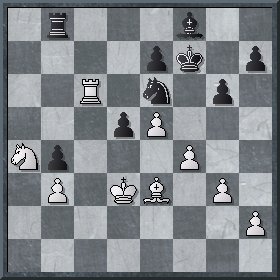
34...¦b7? A blunder, after which Alexey Shirov resigned, preferring not to wait for the evident 35.¦xe6. But Black`s position is anyway cheerless, the ending looks hopeless.1-0
Motylev,A (2647) – Anand,V (2779) [Ґ97]
1.e4 c5 2.¤f3 d6 3.d4 cxd4 4.¤xd4 ¤f6 5.¤c3 a6 6.Ґg5 e6 7.f4 Јb6 8.Јd2 Јxb2 9.¦b1 Јa3
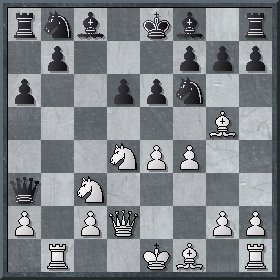
10.e5!? An up-to-date continuation, gaining popularity.It is known that 10.f5 leads to a draw...
10...h6 11.Ґh4 Another possibility 11.Ґxf6 without loss of tempo for a retreat, is also worth investigating.
11...dxe5 12.fxe5 ¤fd7 13.¤e4 Јxa2 14.¦d1 Јd5! 15.Јe3 Јxe5 16.Ґe2 Ґc5 17.Ґg3 Ґxd4 18.¦xd4 Јa5+ 19.¦d2 0-0 20.Ґd6 ¦d8 21.Јg3 Јf5 22.Ґe5 Јg6 23.Јh4 ¤c6 24.0-0 f5 25.Ґh5 Јh7 26.Ґb2 26.Јg3 fxe4 27.Ґg6 ¤cxe5 28.Ґxh7+ ўxh7 and the black a-pawn is ready for its forcible argument.
26...fxe4 27.¦f7 A beautiful draw could have been attained in the variation 27.Ґf7+ ўh8
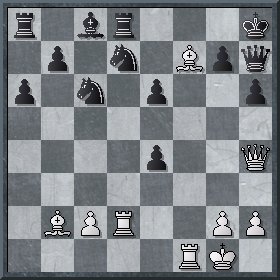
28.¦xd7!! Ґxd7 (28...¦xd7 29.Ґe8 e5 (another way of parting with his queen is worse for Black 29...ўg8 30.Јh5 e5 31.Ґg6) 30.¦f8+ Јg8 31.¦xg8+ ўxg8 32.Ґxd7 Ґxd7 33.Јxe4 should also lead to a draw.) 29.Ґxg7+! Јxg7 30.¦f6 ўh7 31.Јxe4+ ўh8 32.Јf4 ўh7 33.Јe4+
27...¦f8
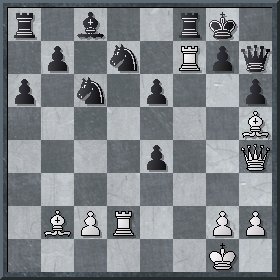
28.Јf2? Excessive emotion and lack of time must have intruded into a course of the game.28.¦xg7+ Јxg7 29.Ґxg7 ўxg7 30.Јg4+ ўh8 31.Јg6 ¦f6 32.Јe8+ ¦f8 33.Јg6 leads to a logical draw by move repetition.
28...¦xf7 29.Јxf7+ ўh8 30.¦f2 e5 31.Јd5 ¤f6 0-1
Carlsen,M (2690) – Navara,D (2719) [D87]
1.d4 ¤f6 2.c4 g6 3.¤c3 d5 4.cxd5 ¤xd5 5.e4 ¤xc3 6.bxc3 Ґg7 7.Ґc4 c5 8.¤e2 ¤c6 9.Ґe3 0-0 10.0-0 Ґd7 11.¦b1 Јc7 12.Ґf4 Јc8 13.d5 ¤a5 14.Ґd3 e5 15.Ґg3 f5!? 15...c4 16.Ґc2 b6 17.Јd2 ¤b7 18.f4 f6, as Boris Avrukh played against me, is much more safe, but promises nothing much about chances for an active play (Sakaev-Avrukh, Izmir 2004).
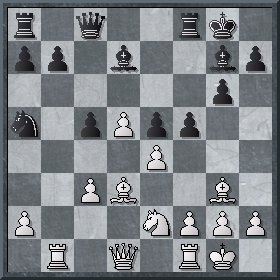
16.f4! fxe4 17.Ґxe4 ¤c4 18.Јd3 18.d6 ¤e3 19.Ґxb7 (19.Јd3 ¤xf1 20.¦xf1 c4! 21.Јd5+ Ґe6 22.Јb5 a6 23.Јb6 exf4 24.¤xf4 ¦b8 is much too reckless) 19...¤xd1 20.Ґxc8 ¦axc8 21.¦bxd1 Ґb5 allows Black to hold on.
18...¤d6 19.fxe5 ¤xe4 20.Јxe4 Ґf5 21.Јc4! A right square to retreat on![The queen on the e-file feels uncomfortable 21.Јe3 Ґxb1 22.¦xb1 Јf5 23.¦d1 (23.¦e1? ¦ae8 24.¤c1 Ґxe5 25.Ґxe5 ¦xe5 26.Јxe5 Јf2+ 27.ўh1 Јf1+) 23...Ґxe5 24.Јxe5 Јxe5 25.Ґxe5 ¦fe8! 26.Ґc7 ¦xe2 27.d6 ¦ee8 , and even a draw is problematical for Black in the ending.]
21...Ґxb1 22.d6+ ўh8 23.¦xb1 Јf5

24.¦e1! Ґxe5 25.¤d4! Ґxd4+ 26.cxd4 ¦ae8 27.¦xe8 ¦xe8 28.h3 28.Ґe5+ ¦xe5 29.dxe5 Јxe5 30.d7 Јa1+ 31.ўf2 Јf6+ 32.ўg3 Јg5+ lead to a draw.
28...ўg7 29.Јb5 A draw was still possible29.Ґe5+ ¦xe5 30.dxe5 Јxe5 31.d7 , after 31...Јd6 there is a save 32.Јc3+ ўf7 33.Јh8
29...¦d8 30.dxc5 ¦d7 Centralization of the queen looks quite attractive too 30...Јd5! Later on Black is planning the transference of the rook to f7 over f8 and advancing the g- and h-pawns.
31.a4
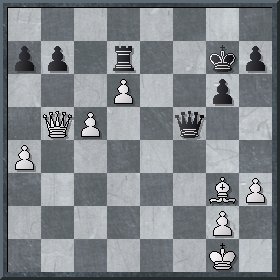
31...g5?? Ablunder. David forgot to make the preliminary move ¦d7-f7, which not only defends the queen, but also activates the rook
32.a5?? Compliment returned. Simple 32.c6 leads to an immediate victory.
32...a6 33.Јc4 h5 34.Ґe1 ¦f7
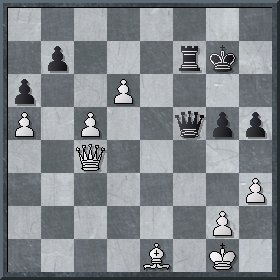
35.c6? The exchange is not so bad in itself,but with it White loses an important tempo, letting Black carry out g5-g4 freely. The right move is 35.Јd4+ ўh7 (On 35...ўg6 there follows 36.Ґd2 g4 37.Јe3) 36.Ґd2 (to exchange the queens is dangerous 36.Ґc3 Јf1+ 37.ўh2 Јf4+ 38.Јxf4 gxf4 – it is still a question, whether White could achieve a draw here.) 36...g4 37.hxg4 Јxg4 38.Јe3 , and a draw is highly probable.
35...bxc6 36.Ґc3+ ўh7 37.Јxc6 Јf2+ 38.ўh1 Јf1+ 39.ўh2 Јf4+ 40.ўh1 Јf1+ 41.ўh2 Јf4+ 42.ўh1 g4 Now it is all over. 43.hxg4 hxg4 44.Јc8 g3 45.Јh8+ ўg6 46.Јg8+ ўh5 47.Јh8+ Јh6 48.Јxh6+ ўxh6 49.ўg1 ўg5 50.Ґd4 ¦f5 0-1
